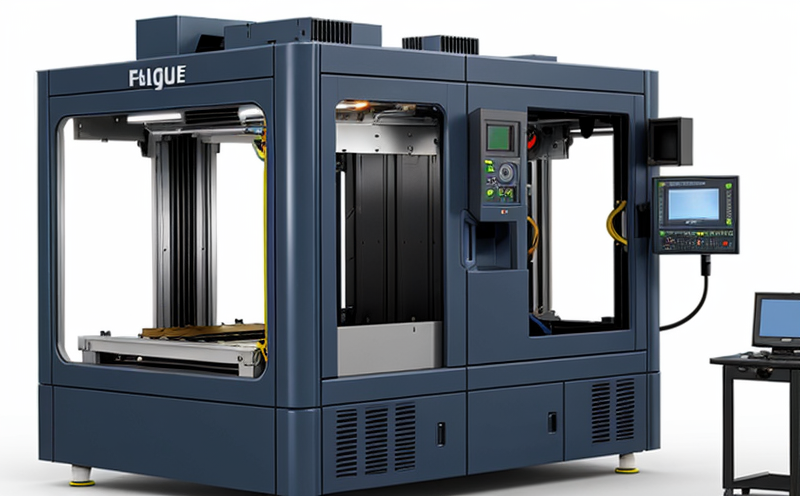ASTM E466 Axial Fatigue Testing of Metallic Materials
The ASTM E466 standard specifies procedures for conducting axial fatigue tests on metallic materials using a rotating-beam apparatus. This test is crucial in understanding the cyclic loading behavior and failure mechanisms of metallic components under repeated stress cycles, which is particularly important in industries such as aerospace, automotive, and medical devices where reliability and durability are paramount.
The rotating-beam fatigue tester applies a series of varying loads to specimens that rotate at high speeds. This method simulates real-world conditions more accurately than other types of testing because it closely mimics the stress state experienced by components in use. The test is designed to determine the number of cycles (Nf) before failure, which provides critical insights into the fatigue life and endurance limit of a material.
Specimens for ASTM E466 are typically cylindrical or disc-shaped, machined from the same batch as production parts to ensure representative results. Preparing specimens involves ensuring they have uniform geometry, free of defects, and meeting strict dimensional tolerances defined in the standard. The rotating-beam apparatus can accommodate various specimen sizes, but it is essential that the dimensions are within the specified range for accurate testing.
The test setup includes a rotating spindle on which the specimen is mounted. The spindle rotates at controlled speeds, applying cyclic axial loads to the sample until failure occurs. Load and displacement are continuously monitored using strain gauges and other sensors. Data collected during testing is used to calculate stress ranges (R) and mean stresses (S), which are crucial for interpreting fatigue behavior.
The results of ASTM E466 tests are reported as the number of cycles to failure, the fatigue strength, and the endurance limit. Fatigue strength refers to the highest stress level that a material can withstand without failing after a specified number of cycles. The endurance limit is the lowest stress at which no specimen fails in an infinite number of cycles.
Understanding these parameters helps engineers design components with longer lifespans and better reliability, reducing the risk of premature failure due to fatigue. This information is vital for quality assurance teams and compliance officers ensuring that materials meet safety standards and performance specifications.
In addition to ASTM E466, other related standards such as ISO 12103-1:2015 provide complementary methods for evaluating the fatigue properties of metallic materials. By integrating multiple testing protocols, industries can gain a comprehensive understanding of material behavior under cyclic loading conditions.
Why It Matters
The results of ASTM E466 axial fatigue tests are critical in ensuring product reliability and safety across various sectors. In aerospace, for instance, the durability of components like turbine blades directly impacts aircraft performance and passenger safety. Automotive manufacturers rely on such data to enhance the longevity of engine parts and ensure vehicle reliability over extended use.
In medical device manufacturing, accurate fatigue testing is essential for ensuring that implants and other devices can withstand the stresses they will encounter during use without failing prematurely. This reduces the risk of adverse events and enhances patient care.
For quality managers and compliance officers, ASTM E466 provides a standardized approach to evaluating materials used in production processes. By adhering to this standard, companies can demonstrate their commitment to meeting international safety and performance standards. This is particularly important for industries subject to regulatory oversight, such as aerospace and medical devices.
The test results also play a key role in R&D efforts aimed at developing new materials with enhanced fatigue properties. Engineers use the data generated from ASTM E466 tests to refine material compositions and manufacturing processes, ultimately leading to improved product performance.
Industry Applications
The aerospace industry heavily relies on ASTM E466 testing due to the stringent safety requirements of aircraft components. Turbine blades, engine parts, and structural elements all undergo fatigue tests to ensure they can withstand the cyclic loading experienced during flight operations.
In automotive manufacturing, the durability of engine blocks, transmission gears, and suspension systems is evaluated using ASTM E466. The test results help engineers design components that can operate reliably under various driving conditions for extended periods.
The medical device sector benefits from ASTM E466 testing in ensuring the longevity and safety of implants, prosthetics, and other surgical devices. By simulating real-world loading conditions, this test helps identify potential weaknesses in design or manufacturing processes that could lead to early failures.
For companies involved in structural engineering, ASTM E466 provides valuable data for assessing the fatigue behavior of materials used in bridges, buildings, and other large structures. This information is crucial for designing structures capable of withstanding environmental stresses over long periods.
Customer Impact and Satisfaction
Customers seeking to ensure product reliability and compliance with international standards benefit greatly from ASTM E466 testing services. By providing accurate and consistent test results, our laboratory enhances customer satisfaction through:
-
Improved product qualityEnsuring that components meet stringent fatigue performance requirements helps reduce the risk of failures in critical applications.
-
Enhanced regulatory complianceMeeting international standards like ASTM E466 demonstrates a commitment to safety and quality, which is crucial for industries regulated by government agencies.
-
Cost savings through early identification of issuesIdentifying potential weaknesses in materials or design during development stages can prevent costly redesigns and recalls later on.
-
Increased market competitivenessOffering products that exceed industry expectations sets a company apart from its competitors, fostering customer loyalty and trust.
-
Better informed decision-makingTest results provide valuable insights into material performance, aiding in strategic planning for future product development efforts.
-
Longer-term business relationshipsConsistent high-quality testing services build strong partnerships with clients and contribute to long-term success.
-
Improved reputationDemonstrating expertise in critical areas like fatigue testing enhances a company's reputation as a leader in quality assurance.
-
Reduced risk of product liability claimsProviding robust evidence that materials and components meet or exceed safety standards helps protect against potential legal challenges.





